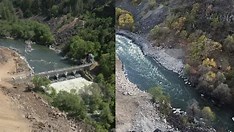On Oct. 3, researchers saw something nobody had seen for a century. Chinook salmon were swimming freely along the Klamath River in California and Oregon.
The arrival of the salmon signaled that the last and largest dam standing of the four hydroelectric dams on the river, the Iron Gate dam, was no more. The dam officially came down on Oct. 2. Iron Gate, the farthest dam downstream on the river, was 173 feet high, 740 feet long. The earthfill structure was completed in California in 1962.

Damon Goodman of the conservation group California Trout told the Associated Press, “It’s been over one hundred years since a wild salmon last swam through this reach of the Klamath River. I am incredibly humbled to witness this moment and share this news, standing on the shoulders of decades of work by our Tribal partners, as the salmon return home.”
Taking down the Klamath dams represents the largest dam removal project in U.S. history. It was accomplished in remarkable speed. The project began at the end of May last year, meaning four dams were removed and the watershed restored in 18 months.
The dam removal is the culmination of some 20 years of regulatory wrangling, which began early this century with the expiration of the FERC license for the project. The license expired in 2006 and the operated under an annual license. In 2004, PacifiCorp, in a relicense request, proposed to trap fish downstream of the dams and transport them to above the dams.
FERC rejected that plan, telling the utility it would have to install fish ladders at each of the dams to get the license renewed. The utility rejected the FERC demand as too expensive. That led to predictable regulatory, litigatory, and legislative back-and-forth until a settlement agreement in 2020 that FERC approved in 2022 to take down the dams.
The four dams were approximately 190 to 225 river miles upstream of where the Klamath River meets the Pacific Ocean. The total length of the river is 257 miles. In terms of discharge, it is the second largest river in California, after the Sacramento River.
The other dams taken down were J.C. Boyle, farthest upstream, at 63 feet tall, 693 feet long, completed in 1958; Copco No. 1, the next furthest up stream, at 126 feet tall, 415 feet long, built in 1918; and Copco No. 2, just a quarter of a mile downstream from Copco No. 1 and smallest on the river, 33 feet tall, 278 feet long, completed in 1925. Demolition began with Copco. No. 2, followed by J.C. Boyle, Copco No. 1, and Iron Gate. The dams made only a small contribution to giant utility PacifiCorp’s generating capacity, about 163 MW.
Local tribes have been fighting for years to free the Klamath, once a principal source of food – both salmon and steelhead trout — as well as being culturally and spiritually significant. The Klamath was once known as the third largest salmon-producing river on the West Coast south of Alaska. “They were gifted to us by our creator and given to us to preserve and to protect and also to help give us life,” said Jeff Mitchell, chair of the Yurok Tribe’s Culture and Heritage Committee and former tribal chairman. “As such, the creator also instructed us to make sure that we do everything in our power to protect those fish.”
The work around the dams will not end once they are gone, as Oregon Public Radio has noted. Habitat restoration will follow, led by Virginia-based Resource Environmental Solutions, which bills itself as “the nation’s largest ecological restoration company.” The radio account said, “The revegetation of the Klamath River has been called the largest river restoration project in American history. Collecting, propagating, and growing enough seeds and plants to populate the reservoir footprints — approximately 2,200 acres in all — is a staggering task. RES launched the effort in 2019, recruiting and training crews from area tribes to collect seed and prepare the ground, and partnering with commercial nurseries to propagate plants and seeds.”
–Kennedy Maize
The Quad Report
To comment:
kenmaize@gmail.com



